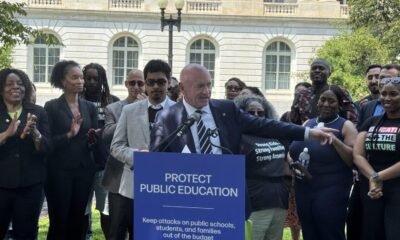corrections
State Agencies and Education Groups Unite to Broaden Education Opportunities for Inmates

In a significant move toward enhancing education for the incarcerated population, Arizona’s state agencies are breaking out of their silos. The Arizona Board of Regents and the Arizona Department of Corrections, Rehabilitation, and Reentry have teamed up with national education organizations and four other states to explore and expand educational programming for inmates.
Ashley Oddo, the deputy director for the Department of Corrections, emphasized the need for growth in the existing programs. “Part of this initiative is mapping out what exists and then identifying those gaps,” she said, highlighting the importance of equipping inmates with necessary tools for better outcomes.
Currently, Arizona offers limited post-secondary educational opportunities through partnerships with local colleges, including Arizona State University and Pima Community College. The programs range from functional literacy and special education to GED and career technical training. Oddo noted that while about 20% of the incarcerated population is enrolled in educational programs, around 50% participate in work programs.
On May 29, Arizona joined a learning community organized by the State Higher Education Executive Officers Association (SHEEO) and partners from Kentucky, Louisiana, Minnesota, and Virginia. This initiative will assess existing programs, revise policies, and align educational offerings with workforce demands over the next year.
The timing aligns with the recent reinstatement of Pell Grant eligibility for incarcerated individuals, which took effect in July 2023. “Literally overnight, 700,000 people became eligible for Pell,” stated Molly Lasagna from Ascendium Education Group. This change has heightened the need for collaboration among state agencies to meet the growing demand for educational opportunities.
Lasagna pointed out the challenges posed by siloed state agencies, which often lack a collaborative history. “We are all facing the same direction… but the goals are the same,” she remarked. Open dialogue at the state level is essential to overcome these challenges.
Roxanne Murphy, director of postsecondary attainment at the Arizona Board of Regents, described a recent meeting with the Department of Corrections as “eye-opening.” The initiative aims to promote information sharing between agencies and explore challenges faced both locally and nationwide.
John Lane from SHEEO highlighted that incarcerated students often remain an “invisible population” in post-secondary education attainment goals. Murphy echoed this concern, noting that Arizona has not fully addressed this population’s role in achieving state educational objectives.
As a technical meeting approaches, aimed at refining specific goals, stakeholders remain focused on bridging educational opportunities for incarcerated individuals. “Education doesn’t stop when someone is released; it can continue to foster safer communities and stronger reentry outcomes,” Oddo concluded.


















